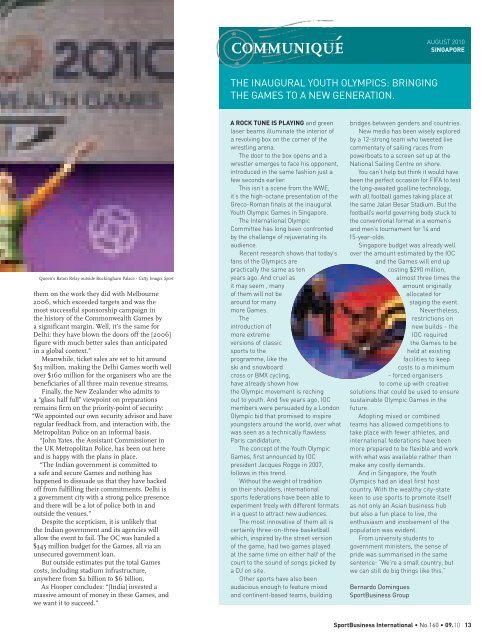4 - FIFA/CIES International University Network
4 - FIFA/CIES International University Network
4 - FIFA/CIES International University Network
You also want an ePaper? Increase the reach of your titles
YUMPU automatically turns print PDFs into web optimized ePapers that Google loves.
COMMUNIQUE<br />
AUGUST 2010<br />
SINGAPORE<br />
THE INAUGURAL YOUTH OLYMPICS: BRINGING<br />
THE games TO A NEW GENERATION.<br />
Queen’s Baton Relay outside Buckingham Palace - Getty Images Sport<br />
them on the work they did with Melbourne<br />
2006, which exceeded targets and was the<br />
most successful sponsorship campaign in<br />
the history of the Commonwealth Games by<br />
a significant margin. Well, it’s the same for<br />
Delhi: they have blown the doors off the [2006]<br />
figure with much better sales than anticipated<br />
in a global context.”<br />
Meanwhile, ticket sales are set to hit around<br />
$13 million, making the Delhi Games worth well<br />
over $160 million for the organisers who are the<br />
beneficiaries of all three main revenue streams.<br />
Finally, the New Zealander who admits to<br />
a “glass half full” viewpoint on preparations<br />
remains firm on the priority-point of security:<br />
“We appointed our own security advisor and have<br />
regular feedback from, and interaction with, the<br />
Metropolitan Police on an informal basis.<br />
“John Yates, the Assistant Commissioner in<br />
the UK Metropolitan Police, has been out here<br />
and is happy with the plans in place.<br />
“The Indian government is committed to<br />
a safe and secure Games and nothing has<br />
happened to dissuade us that they have backed<br />
off from fulfilling their commitments. Delhi is<br />
a government city with a strong police presence<br />
and there will be a lot of police both in and<br />
outside the venues.”<br />
Despite the scepticism, it is unlikely that<br />
the Indian government and its agencies will<br />
allow the event to fail. The OC was handed a<br />
$345 million budget for the Games, all via an<br />
unsecured government loan.<br />
But outside estimates put the total Games<br />
costs, including stadium infrastructure,<br />
anywhere from $2 billion to $6 billion.<br />
As Hooper concludes: “[India] invested a<br />
massive amount of money in these Games, and<br />
we want it to succeed.”<br />
A rock tune is playing and green<br />
laser beams illuminate the interior of<br />
a revolving box on the corner of the<br />
wrestling arena.<br />
The door to the box opens and a<br />
wrestler emerges to face his opponent,<br />
introduced in the same fashion just a<br />
few seconds earlier.<br />
This isn’t a scene from the WWE,<br />
it’s the high-octane presentation of the<br />
Greco-Roman finals at the inaugural<br />
Youth Olympic Games in Singapore.<br />
The <strong>International</strong> Olympic<br />
Committee has long been confronted<br />
by the challenge of rejuvenating its<br />
audience.<br />
Recent research shows that today’s<br />
fans of the Olympics are<br />
practically the same as ten<br />
years ago. And cruel as<br />
it may seem , many<br />
of them will not be<br />
around for many<br />
more Games.<br />
The<br />
introduction of<br />
more extreme<br />
versions of classic<br />
sports to the<br />
programme, like the<br />
ski and snowboard<br />
cross or BMX cycling,<br />
have already shown how<br />
the Olympic movement is reching<br />
out to youth. And five years ago, IOC<br />
members were persuaded by a London<br />
Olympic bid that promised to inspire<br />
youngsters around the world, over what<br />
was seen as a technically flawless<br />
Paris candidature.<br />
The concept of the Youth Olympic<br />
Games, first announced by IOC<br />
president Jacques Rogge in 2007,<br />
follows in this trend.<br />
Without the weight of tradition<br />
on their shoulders, international<br />
sports federations have been able to<br />
experiment freely with different formats<br />
in a quest to attract new audiences.<br />
The most innovative of them all is<br />
certainly three-on-three basketball<br />
which, inspired by the street version<br />
of the game, had two games played<br />
at the same time on either half of the<br />
court to the sound of songs picked by<br />
a DJ on site.<br />
Other sports have also been<br />
audacious enough to feature mixed<br />
and continent-based teams, building<br />
bridges between genders and countries.<br />
New media has been wisely explored<br />
by a 12-strong team who tweeted live<br />
commentary of sailing races from<br />
powerboats to a screen set up at the<br />
National Sailing Centre on shore.<br />
You can’t help but think it would have<br />
been the perfect occasion for <strong>FIFA</strong> to test<br />
the long-awaited goalline technology,<br />
with all football games taking place at<br />
the same Jalan Besar Stadium. But the<br />
football’s world governing body stuck to<br />
the conventional format in a women’s<br />
and men’s tournament for 14 and<br />
15-year-olds.<br />
Singapore budget was already well<br />
over the amount estimated by the IOC<br />
and the Games will end up<br />
costing $290 million,<br />
almost three times the<br />
amount originally<br />
allocated for<br />
staging the event.<br />
Nevertheless,<br />
restrictions on<br />
new builds - the<br />
IOC required<br />
the Games to be<br />
held at existing<br />
facilities to keep<br />
costs to a minimum<br />
- forced organisers<br />
to come up with creative<br />
solutions that could be used to ensure<br />
sustainable Olympic Games in the<br />
future.<br />
Adopting mixed or combined<br />
teams has allowed competitions to<br />
take place with fewer athletes, and<br />
international federations have been<br />
more prepared to be flexible and work<br />
with what was available rather than<br />
make any costly demands.<br />
And in Singapore, the Youth<br />
Olympics had an ideal first host<br />
country. With the wealthy city-state<br />
keen to use sports to promote itself<br />
as not only an Asian business hub<br />
but also a fun place to live, the<br />
enthusiasm and involvement of the<br />
population was evident.<br />
From university students to<br />
government ministers, the sense of<br />
pride was summarised in the same<br />
sentence: “We’re a small country, but<br />
we can still do big things like this.”<br />
Bernardo Domingues<br />
SportBusiness Group<br />
SportBusiness <strong>International</strong> • No.160 • 09.10 13

















